How Were Steel Mill Workers Exposed to Asbestos?
For decades, the steel industry used a wide range of asbestos-containing products and materials to help with fireproofing and insulation — putting workers at risk of exposure to asbestos.
Steel mill workers thought asbestos products were safe to use as manufacturers hid the dangerous truth. As a result, many steelworkers develop mesothelioma and other asbestos-related diseases every year.
Quick Facts on Steel Mill Workers and Asbestos
- Almost 700,000 people worked in steel mills between 1948 and 1958, and many were at risk of exposure to asbestos.
- Hundreds of mills and steelmaking work sites used asbestos materials like insulation, boilers, gaskets, and pipes.
- A former steel mill worker with mesothelioma received $250 million (the largest asbestos verdict in history) by working with our legal partners.
Mesothelioma Hope stands ready to help steel mill workers, their loved ones, and anyone else affected by this cancer.
Get our Free Mesothelioma Guide to explore treatments, compensation options, and other key resources.
Asbestos Products Used at Steel Mills
Before their health risks were publicly known, asbestos products were popular in steel mill work since they helped protect from fire, water, and corrosion.
Common steel mill asbestos products included:
- Boilers: Boilers produced steam and water for use in the steelmaking process. Asbestos materials helped the boilers operate under high heat and pressure.
- Gaskets: Asbestos was used to help gaskets withstand friction and pressure.
- Insulation: Steel mills used asbestos insulation to fireproof ceiling tiles, walls, and equipment.
- Molds: Steel molds were often made of asbestos cement to withstand high temperatures in stoves and ovens.
- Protective clothing: Aprons, face masks, coats, pants, gloves, and coveralls contained asbestos to protect steel mill workers from burns.
- Refractory bricks: Bricks made with asbestos cement were used around ovens, stoves, and combustion chambers of boilers.
- Steam pipes: Pipes and piping systems within steel mill plants also contained asbestos insulation.
As products containing asbestos in steel mills were used or worn down, they could release fibers into the air. Workers who breathed in or swallowed the asbestos fibers could develop internal irritation and serious illnesses later in life.
High-Risk Asbestos Exposure Jobs in Steel Mills
People who worked with asbestos products on an everyday basis are at the highest risk of developing mesothelioma today.
- Blacksmiths
- Blast furnace workers
- Boilermakers
- Bricklayers
- Casters and pourers
- Insulators
- Machinists
- Maintenance workers
- Metalworkers
- Millwrights
- Motor inspectors
- Plumbers and pipefitters
- Tenders
- Welders
Family members could have also suffered secondhand asbestos exposure. When steelworkers came home, they may have brought asbestos fibers with them on clothing, hair, or skin, putting loved ones in danger of mesothelioma later in life.
Military Steel Mill Workers and Asbestos Exposure Risks
Civilian steel mill workers weren’t the only ones at risk of asbestos exposure. Many U.S. veterans with mesothelioma served as military steel workers decades ago.
All military branches relied on asbestos between the 1930s and early 1980s. In fact, the U.S. Navy released a report stating that its steelworkers had a “probable” risk of asbestos exposure.
List of Steel Mills That Used Asbestos Products
Hundreds of steel mills across the U.S. relied on asbestos for decades before the public knew about the health risks.
Some of the steel mills that used asbestos include:
- Alan Wood Steel, Philadelphia, PA
- American Steel & Wire, Worcester, MA
- Apex Steel Corp., Los Angeles, CA
- Armco Steel, Houston, TX
- Atlantic Steel Co., Atlanta, GA
- Auburn Steel, Auburn, NY
- Beck Steel Co., St. Louis, MO
- Bell Steel Co., Pensacola, FL
- Bethlehem Steel, Bethlehem, PA
- Border Steel, El Paso, TX
- Calumet Steel, Chicago, IL
- Cambria Steel Co., Johnstown, PA
- Carnegie Illinois Steel Corp., Gary, IN
- Columbia Steel, Union City, CA
- Crucible Steel Co., Syracuse, NY
- Delaware Steel, Wilmington, DE
- Fairless Works U.S. Steel, Fairless, PA
- Florida Steel Corp., Baldwin, FL
- Granite City Steel Co., Granite City, IL
- Hepinstall Steel Co, Kenner, LA
- Kentucky Electric Steel, Ashland, KY
- Laclede Steel Company, Alton, IL
- Marathon Steel Co., Tempe, AZ
- Mosher Steel Co., Houston, TX
- National Steel Co., New York City, NY
- Passaic Steel Co., Paterson, NJ
- Patterson Steel & Forge Co., Stratford, CT
- Portland Iron & Steel Co., Portland, ME
- Republic Steel, Birmingham, AL
- Scullin Steel Co., Baltimore, MD
- Sheffield Steel Corp., Kansas City, MO
- Smith & Moon Steel Co, Winfield, KS
- Southern Steel Co., New York City, NY
- Texas Steel Co., Fort Worth, TX
- Trinity Steel, Dallas, TX
- U. S. Steel Corp., Houseville, PA
- Western Pipe & Steel Co., San Francisco, CA
- Western Wire & Steel, Lee, MA
- Wilson Steel, Baton Rouge, LA
- Wharton Steel Co., Wharton, NJ
This list is not complete. You or a loved one could have been exposed at a steel mill, even if it’s not shown above.
While many mills are no longer in business, you could still be at risk since it takes 10-50 years for mesothelioma to develop after asbestos exposure.
We can help determine if you or a loved one developed mesothelioma from steel mills. Call (866) 608-8933 now to get answers.
Mesothelioma Compensation for Steel Mill Workers
If you or a loved one worked at a steel mill and developed mesothelioma or other asbestos-related illnesses, you may qualify for compensation.
Mesothelioma compensation can help cover medical bills and protect your family’s financial future after a diagnosis.
Asbestos steel mill compensation options include:
- Mesothelioma lawsuits: The average mesothelioma lawsuit awards over $1 million. Our legal partners do all the legal work for you, so you can get compensation with less stress.
- Asbestos trust funds: These trusts were established by bankrupt manufacturers of asbestos products under court order to avoid lawsuits. There is over $30 billion available in trusts today. Our partner attorneys can file trust fund claims on your behalf.
- VA benefits: If you’re a veteran with mesothelioma, you may qualify for benefits from the US Department of Veterans Affairs (VA). Key VA benefits include disability compensation worth nearly $4,000 a month in most cases and free or inexpensive medical care.
Our partner law firm, Simmons Hanly Conroy, secured $250 million for a former steel mill worker — the largest mesothelioma verdict in history. The firm may be able to help you get legal compensation, too.
Get a Free Case Review with our team to find out if you’re eligible for mesothelioma payouts.
Steel Mill Workers and Asbestos: Get Help Now
For decades, steel mill workers unknowingly put their health at risk due to asbestos exposure.
If you or someone you love has mesothelioma after working in a steel mill, Mesothelioma Hope stands ready to support you in this trying time.
Our team can help you:
- Find top doctors and hospitals that treat mesothelioma
- Pursue payouts typically worth $1 million or more
- Receive the support you need after a diagnosis
Call (866) 608-8933 or get our Free Mesothelioma Guide now to see all of the ways that we can assist you.
Mesothelioma Steel Mills FAQs
What workers are most at risk from asbestos?
Steel mill workers who handled asbestos-containing materials like gaskets and insulation every day were most at risk from asbestos.
Regular occupational exposure increases the odds of developing cancers like mesothelioma 10-50 years later.
Is working in a steel mill bad for your health?
If you worked in a steel mill before the early 1980s, it could have been bad for your health.
Steel mill workers may have been exposed to asbestos-containing products, which can cause mesothelioma, lung cancer, asbestosis, and other life-threatening diseases.
Contact us now if you or a loved one is a steel mill worker with mesothelioma. We can help you pursue treatments and compensation.
Is there asbestos in steel mills?
Yes, asbestos was used in steel mills across the country for decades. As a result, you or a loved one could have easily been exposed to asbestos by working in a mill.
Many steel mill jobs could have exposed you to asbestos. You were at a very high risk if you worked as an insulator, pipefitter, welder, or mechanic.
These jobs required you to work with or around asbestos-containing materials. As a result, you risked breathing in or swallowing asbestos fibers, which can lead to mesothelioma decades later.


 Get a Free Mesothelioma Case Review
Get a Free Mesothelioma Case Review




